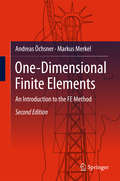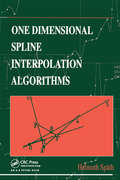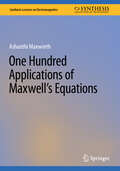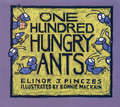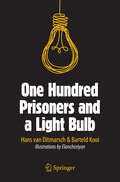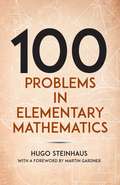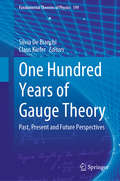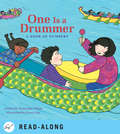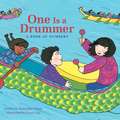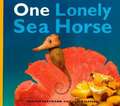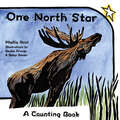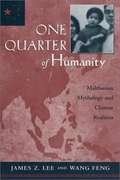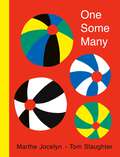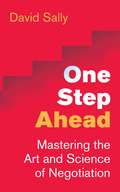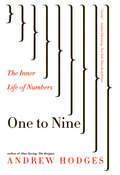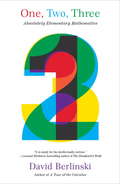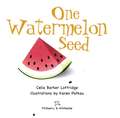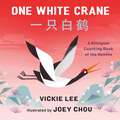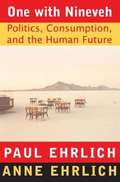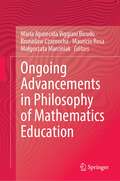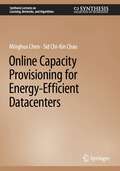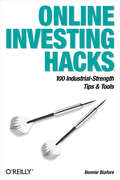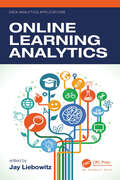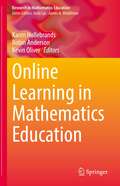- Table View
- List View
One-Dimensional Finite Elements: An Introduction To The Fe Method
by Markus Merkel Andreas ÖchsnerThis textbook presents finite element methods using exclusively one-dimensional elements. It presents the complex methodology in an easily understandable but mathematically correct fashion. The approach of one-dimensional elements enables the reader to focus on the understanding of the principles of basic and advanced mechanical problems. The reader will easily understand the assumptions and limitations of mechanical modeling as well as the underlying physics without struggling with complex mathematics. Although the description is easy, it remains scientifically correct.The approach using only one-dimensional elements covers not only standard problems but allows also for advanced topics such as plasticity or the mechanics of composite materials. Many examples illustrate the concepts and problems at the end of every chapter help to familiarize with the topics. Each chapter also includes a few exercise problems, with short answers provided at the end of the book.The second edition appears with a complete revision of all figures. It also presents a complete new chapter special elements and added the thermal conduction into the analysis of rod elements. The principle of virtual work has also been introduced for the derivation of the finite-element principal equation.
One Dimensional Spline Interpolation Algorithms
by Helmuth SpäthTogether with its compagnion volume this book presents a practical introduction to computing spline functions, the fundamental tools for fitting curves and surfaces in computer-aided design (CAD) and computer graphics.
One Hundred Applications of Maxwell’s Equations (Synthesis Lectures on Electromagnetics)
by Ashanthi MaxworthMaxwell's equations explain the basics of electricity and magnetism. The four equations provide a mathematical model for electric, optical, and radio technologies. And yet, when learning electromagnetic field theory, it is easy to get lost in the complicated mathematics and ignore the applied aspects of it. The purpose of this book is to bridge the gap between theory and applications of Maxwell’s equations. This book introduces readers to the mathematics of Maxwell’s equations and their uses in both everyday applications such as power generation, electric motors, wireless communication, as well as in scientific research. Each chapter in the book starts with an introduction to a specific Maxwell’s equation followed by examples of ways in which the equation is used.
One Hundred Hungry Ants
by Elinor J. PinczesThis tale of ants parading toward a picnic is &“one of those rare gems capable of entertaining while it instructs&” (Middlesex News). One hundred hungry ants march off single file to sample a picnic, but when the going gets too slow, they divide into two rows of fifty, then four rows of twenty-five . . . until they take so long that the picnic is gone! &“The unexpected pairing of sophisticated art and light-hearted text lends this book particular distinction.&” —Publishers Weekly &“The illustrations . . . use a pleasing palette and energetic lines to depict ants with highly individual characters.&” —Horn Book
One Hundred Prisoners and a Light Bulb
by Hans Van Ditmarsch Barteld KooiA group of 100 prisoners, all together in the prison dining area, are told that they will be all put in isolation cells and then will be interrogated one by one in a room containing a light with an on/off switch. The prisoners may communicate with one another by toggling the light switch (and that is the only way in which they can communicate). The light is initially switched off. There is no fixed order of interrogation, or interval between interrogations, and the same prisoner may be interrogated again at any stage. When interrogated, a prisoner can either do nothing, or toggle the light switch, or announce that all prisoners have been interrogated. If that announcement is true, the prisoners will (all) be set free, but if it is false, they will all be executed. While still in the dining room, and before the prisoners go to their isolation cells (forever), can the prisoners agree on a protocol that will set them free? At first glance, this riddle may seem impossible to solve: how can all of the necessary information be transmitted by the prisoners using only a single light bulb? There is indeed a solution, however, and it can be found by reasoning about knowledge. This book provides a guided tour through eleven classic logic puzzles that are engaging and challenging and often surprising in their solutions. These riddles revolve around the characters' declarations of knowledge, ignorance, and the appearance that they are contradicting themselves in some way. Each chapter focuses on one puzzle, which the authors break down in order to guide the reader toward the solution. For general readers and students with little technical knowledge of mathematics, One Hundred Prisoners and a Light Bulb will be an accessible and fun introduction to epistemic logic. Additionally, more advanced students and their teachers will find it to be a valuable reference text for introductory course work and further study.
One Hundred Problems in Elementary Mathematics (Dover Books on Mathematics)
by Martin Gardner Hugo SteinhausBoth a challenge to mathematically inclined readers and a useful supplementary text for high school and college courses, One Hundred Problems in Elementary Mathematics presents an instructive, stimulating collection of problems. Many problems address such matters as numbers, equations, inequalities, points, polygons, circles, ellipses, space, polyhedra, and spheres. An equal number deal with more amusing or more practical subjects, such as a picnic ham, blood groups, rooks on a chessboard, and the doings of the ingenious Dr. Abracadabrus.Are the problems in this book really elementary? Perhaps not in the lay reader’s sense, for anyone who desires to solve these problems must know a fair amount of mathematics, up to calculus. Nevertheless, Professor Steinhaus has given complete, detailed solutions to every one of his 100 problems, and anyone who works through the solutions will painlessly learn an astonishing amount of mathematics. A final chapter provides a true test for the most proficient readers: 13 additional unsolved problems, including some for which the author himself does not know the solutions.
One Hundred Years of Gauge Theory: Past, Present and Future Perspectives (Fundamental Theories of Physics #199)
by Silvia De Bianchi Claus KieferThis book presents a multidisciplinary guide to gauge theory and gravity, with chapters by the world’s leading theoretical physicists, mathematicians, historians and philosophers of science. The contributions from theoretical physics explore e.g. the consistency of the unification of gravitation and quantum theory, the underpinnings of experimental tests of gauge theory and its role in shedding light on the relationship between mathematics and physics. In turn, historians and philosophers of science assess the impact of Weyl’s view on the philosophy of science. Graduate students, lecturers and researchers in the fields of history of science, theoretical physics and philosophy of science will benefit from this book by learning about the role played by Weyl’s Raum-Zeit-Materie in shaping several modern research fields, and by gaining insights into the future prospects of gauge theory in both theoretical and experimental physics. Furthermore, the book facilitates interdisciplinary exchange and conceptual innovation in tackling fundamental questions about our deepest theories of physics. Chapter “Weyl’s Raum-Zeit-Materie and the Philosophy of Science” is available open access under a Creative Commons Attribution 4.0 International License via link.springer.com
One Is a Drummer: A Book of Numbers (Multicultural Shapes And Colors Ser.)
by Roseanne Thong Grace LinThis lively ebook shows that the world around us is filled with things to count. Three are the dim sum carts filled with yummy treats, eight are the candles on a birthday cake, and ten are the bamboo stalks growing in a garden. Many of the featured objects are Asian in origin, but all are universal in appeal. With brilliantly colored illustrations, an ear-pleasing text and an informative glossary, this truly multicultural book will make counting a fun part of every child's day! Plus, this is the fixed format version, which will look almost identical to the print version. Additionally for devices that support audio, this ebook includes a read-along setting.
One Is a Drummer
by Roseanne Thong Grace LinThis lively ebook shows that the world around us is filled with things to count. Three are the dim sum carts filled with yummy treats, eight are the candles on a birthday cake, and ten are the bamboo stalks growing in a garden. Many of the featured objects are Asian in origin, but all are universal in appeal. With brilliantly colored illustrations, an ear-pleasing text and an informative glossary, this truly multicultural book will make counting a fun part of every child's day!
One Lonely Sea Horse
by Saxton Freymann Joost ElffersOne lonely sea horse learns that she has a lot of friends--friends she can really "count" on to help.
One North Star: A Counting Book
by Phyllis RootFive toads hop, four brook trout swim, three elk graze, two loons call, and one beaver gnaws on a paper birch tree, all under one North Star. Through bog and marsh, along river and lake, across prairie and into the woods, children learn what lives where by counting the creatures on foot or in flight, swimming or perching in exquisite woodcut and watercolor illustrations created by Beckie Prange and Betsy Bowen in an artistic collaboration. For those looking for more about the pictured wildlife, Phyllis Root includes fascinating facts and information on the state&’s ecosystems and the plants and animals that make their homes there.
One Quarter of Humanity
by James Z. Lee Wang FengThis book presents evidence about historical and contemporary Chinese population behavior that overturns much of the received wisdom about the differences between China and the West first voiced by Malthus. Malthus described a China in which early and universal marriage ensured high fertility and therefore high mortality. He contrasted this with Western Europe, where marriage occurred late and was far from universal, resulting in lower fertility and higher demographic responsiveness to economic circumstances. The result in China was thought to be mass misery as part of the population teetered on the brink of a Malthusian precipice, whereas in the West conditions were less severe. In reality, James Lee and Wang Feng argue, there has been effective regulation of population growth in China through a variety of practices that depressed marital fertility to levels far below European standards, and through the widespread practices of infanticide and abortion. Moreover, in China, population behavior has long been primarily a consequence of collective intervention. This collective culture underlies four distinctive features of the Chinese demographic pattern--high rates of female infanticide, low rates of male marriage, low rates of marital fertility, and high rates of adoption--that Lee and Wang trace from 1700 to today. These and other distinctive features of the Chinese demographic and social system, they argue, led to a different demographic transition in China from the one that took place in the West.
One Some Many
by Marthe JocelynOne Some Many by Marthe Jocelyn and Tom Slaughter is an excellent early introduction to numbers and to the principles of modern art. It is the perfect companion to 1 2 3, a counting book with a difference. Slaughter’s bold, Matisse-inspired paper cuts illustrate basic artistic elements, including color, form, and line, while the playful and inventive text introduces the concepts of quantity that children find most puzzling (and that adults have the most difficulty explaining!). After all, how many is many? Some? A few?
One Step Ahead: Mastering the Art and Science of Negotiation
by David SallyThe world's best negotiators have moved beyond the conventional wisdom by utilising cutting-edge studies and real-world results. It's time you did too. For over twenty years, David Sally has been teaching the art of negotiation at leading business schools and to executives at top companies. Now, using insights from social psychology and game theory, he delivers the proven, clear, actionable advice you need to stay one step ahead. By studying great examples, from Machiavelli to Wall Street, Xi Jinping and Barack Obama, he explores how the game&’s masters navigate the field strategically, craftily, even emotionally. The best know every negotiation is different and that your tactics are, in part, determined by your opponent. One Step Ahead will make sure that you have what it takes to come out on top, no matter who you are facing across the table.
One to Nine: The Inner Life of Numbers
by Andrew HodgesWhat Lynne Truss did for grammar in Eats, Shoots & Leaves, Andrew Hodges now does for mathematics. Andrew Hodges, one of Britain's leading biographers and mathematical writers, brings numbers to three-dimensional life in this delightful and illuminating volume, filled with illustrations, which makes even the most challenging math problems accessible to the layperson. Inspired by millennia of human attempts to figure things out, this pithy book, which tackles mathematical conundrums from the ancient Greeks to superstring theory, finds a new twist to everything from musical harmony to code breaking, from the chemistry of sunflowers to the mystery of magic squares. Starting with the puzzle of defining unity, and ending with the recurring nines of infinite decimals, Hodges tells a story that takes in quantum physics, cosmology, climate change, and the origin of the computer. Hodges has written a classic work, at once playful but satisfyingly instructional, which will be ideal for the math aficionado and the Sudoku addict as well as for the life of the party.
One, Two, Three: Absolutely Elementary Mathematics
by David BerlinskiFrom the acclaimed author of A Tour of the Calculus and The Advent of the Algorithm, here is a riveting look at mathematics that reveals a hidden world in some of its most fundamental concepts. In his latest foray into mathematics, David Berlinski takes on the simplest questions that can be asked: What is a number? How do addition, subtraction, multiplication, and division actually work? What are geometry and logic? As he delves into these subjects, he discovers and lucidly describes the beauty and complexity behind their seemingly simple exteriors, making clear how and why these mercurial, often slippery concepts are essential to who we are. Filled with illuminating historical anecdotes and asides on some of the most fascinating mathematicians through the ages, One, Two, Three is a captivating exploration of the foundation of mathematics: how it originated, who thought of it, and why it matters.From the Hardcover edition.
One Watermelon Seed
by Celia Barker LottridgeIn this deceptively simple counting book, Max and Josephine tend their garden while readers follow along, counting from one to ten as the garden is planted. Then readers can count in groups of tens as the garden is harvested, while they search through the pictures for the many small animals that are hiding throughout. A concise and clever text introduces color and rhythm, and the illustrations are bright and engaging, making this a perfect counting book for children aged four to seven.
One White Crane: A Bilingual Counting Book of the Months
by Vickie LeeOne white crane, two black bears . . .Simply told and beautifully rendered, this counting board book takes young readers through the months of the year. Each month focuses on a new animal, from seals in May to cicadas in September. Sweet, accessible text in English and Chinese pairs with eye-catching art for a wonderful repeat reading experience.
One With Nineveh: Politics, Environment, and the Human Future
by Paul R. Ehrlich Anne H. Ehrlich"Through lucid explanations, telling anecdotes, and incisive analyses, the eminent scientists Paul Ehrlich and Anne Ehrlich here spotlight the three elephants in our global living room--rising consumption, increasing world population, and unchecked political and economic inequity--that together are increasingly shaping today's politics, undermining the planet's ability to sustain us, and determining humankind's future. The result is a book that brilliantly puts today's policy debates in a larger context and makes a compelling case for the critical discussions that we should be having." (From the book jacket.)
Ongoing Advancements in Philosophy of Mathematics Education
by Maria Aparecida Viggiani Bicudo Bronislaw Czarnocha Maurício Rosa Małgorzata MarciniakOngoing Advancements in Philosophy of Mathematics Education approaches the philosophy of mathematics education in a forward movement, analyzing, reflecting, and proposing significant contemporary themes in the field of mathematics education. The theme that gives life to the book is philosophy of mathematics education understood as arising from the intertwining between philosophy of mathematics and philosophy of education which, through constant analytical and reflective work regarding teaching and learning practices in mathematics, is materialized in its own discipline, philosophy of mathematics education. This is the field of investigation of the chapters in the book. The chapters are written by an international cohort of authors, from a variety of countries, regions, and continents. Some of these authors work with philosophical and psychological foundations traditionally accepted by Western civilization. Others expose theoretical foundations based on a new vision and comprising innovative approaches to historical and present-day issues in educational philosophy. The final third of the book is devoted to these unique and innovative research stances towards important and change resistant societal topics such as racism, technology gaps, or the promotion of creativity in the field of mathematics education.
Online Capacity Provisioning for Energy-Efficient Datacenters (Synthesis Lectures on Learning, Networks, and Algorithms)
by Minghua Chen Sid Chi-Kin ChauThis book addresses the urgent issue of massive and inefficient energy consumption by data centers, which have become the largest co-located computing systems in the world and process trillions of megabytes of data every second. Dynamic provisioning algorithms have the potential to be the most viable and convenient of approaches to reducing data center energy consumption by turning off unnecessary servers, but they incur additional costs from being unable to properly predict future workload demands that have only recently been mitigated by advances in machine-learned predictions.This book explores whether it is possible to design effective online dynamic provisioning algorithms that require zero future workload information while still achieving close-to-optimal performance. It also examines whether characterizing the benefits of utilizing the future workload information can then improve the design of online algorithms with predictions in dynamic provisioning. The book specifically develops online dynamic provisioning algorithms with and without the available future workload information. Readers will discover the elegant structure of the online dynamic provisioning problem in a way that reveals the optimal solution through divide-and-conquer tactics. The book teaches readers to exploit this insight by showing the design of two online competitive algorithms with competitive ratios characterized by the normalized size of a look-ahead window in which exact workload prediction is available.
Online Investing Hacks: 100 Industrial-Strength Tips & Tools
by Bonnie BiaforeFor the geek who's an investor, and the investor who's a geek, we present Online Investing Hacks, 100 industrial-strength, bleeding edge tips, tools and techniques for analyzing and managing online portfolios.Individual investors have become more computer-literate and technology-dependent than ever before. Whether you're looking for suitable investments, studying alternatives, or managing your portfolios, you need data. The Internet can be a goldmine of financial data and research, but today's online investors also use spreadsheets, databases, and financial applications to select, study and manage investments. If your proficiency has grown to the point where you crave industrial-strength tips and tools to turbo-charge your efforts, this is the book for you.Online Investing Hacks covers:Screening InvestmentsCollecting DataFundamental AnalysisTechnical AnalysisExecuting TradesInvesting in Mutual FundsPortfolio ManagementUpdating Stock DataFinancial PlanningOther books for managing online investing are either out of date, are for beginners and don't go beyond the most basic advice, or are so dull and boring they squeeze that last bit of fun out of the topic. Online Investing Hacks is for the customer who wants to know the latest techniques, to go beyond the basics, who gets jazzed by cool online tools and services, and who actually wants to have a bit of fun while trying to strike it rich (or at least not lose their shirt).
Online Learning Analytics (Data Analytics Applications)
by Jay Liebowitz"In our increasingly digitally enabled education world, analytics used ethically, strategically, and with care holds the potential to help more and more diverse students be more successful on higher education journeys than ever before. Jay Liebowitz and a cadre of the fields best ‘good trouble’ makers in this space help shine a light on the possibilities, potential challenges, and the power of learning together in this work." —Mark David Milliron, Ph.D., Senior Vice President and Executive Dean of the Teachers College, Western Governors University Due to the COVID-19 pandemic and its aftereffects, we have begun to enter the "new normal" of education. Instead of online learning being an "added feature" of K–12 schools and universities worldwide, it will be incorporated as an essential feature in education. There are many questions and concerns from parents, students, teachers, professors, administrators, staff, accrediting bodies, and others regarding the quality of virtual learning and its impact on student learning outcomes. Online Learning Analytics is conceived on trying to answer the questions of those who may be skeptical about online learning. Through better understanding and applying learning analytics, we can assess how successful learning and student/faculty engagement, as examples, can contribute towards producing the educational outcomes needed to advance student learning for future generations. Learning analytics has proven to be successful in many areas, such as the impact of using learning analytics in asynchronous online discussions in higher education. To prepare for a future where online learning plays a major role, this book examines: Data insights for improving curriculum design, teaching practice, and learning Scaling up learning analytics in an evidence-informed way The role of trust in online learning. Online learning faces very real philosophical and operational challenges. This book addresses areas of concern about the future of education and learning. It also energizes the field of learning analytics by presenting research on a range of topics that is broad and recognizes the humanness and depth of educating and learning.
Online Learning in Mathematics Education (Research in Mathematics Education)
by Kevin Oliver Robin Anderson Karen HollebrandsThis book brings together research from mathematics education and instructional design to describe the development and impact of online environments on prospective and practicing teachers’ learning to teach mathematics. The move to online learning has steadily increased over the past decade. Its most rapid movement occurring in 2020 with most instruction taking place remotely. Chapters in this book highlight issues related to teacher learning in three main contexts: formal, informal, and experiential or practice-based. This volume brings together researchers from the different but related fields of instructional design and mathematics education to engage in dialogue around how we design and study the impacts of online learning in general and online mathematics education more specifically. The book is very timely with most instruction taking place online and mathematics educators addressing challenges related to supporting teachers’ formal, informal, and experiential learning online. A chapter in each section will synthesize ideas presented by instructional designers and mathematics educators as it relates to teacher learning in each context. At the end of each section, a retrospective chapter is presented to reflect on what the different perspectives offer to better understand mathematics teacher learning in online environments. This book is of interest to mathematics educators, researchers, teacher educators, professional development providers, and instructional designers.
